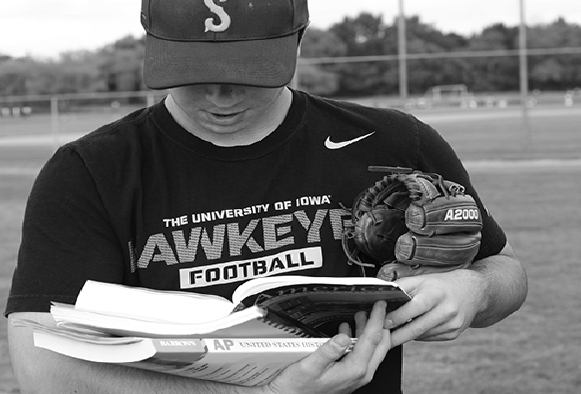Do social misconceptions affect life choices?

Alexandra Shafran
STOPPING STEREOTYPES. Picking up books on the field, Justin Stark ’16 breaks the social stereotype of athletes. Stark balances his sports and academics on and off the field.
During the passing period, the football player makes his way past the cardio room and instead sits down in his advanced math class, waiting for the test that he studied diligently for to be passed out.
Instead of cutting class, the lead singer of the popular student-made band cuts practice short to study for his AP English quiz.
The fashionista, who many believe can break her acrylic nails at any moment, goes to her local gym every day.
With an often more negative than positive connotation, stereotypes often shape societal expectations for numerous types of people- and hurt certain individuals within society. Among those who are characterized by stereotypes, students have been grouped based on their attitude, clothing, music taste and more.
“We want to consider how stereotypes are used,” said Gary Alan Fine, sociology professor at Northwestern University. “To the extent that a stereotype means that you’re over generalizing; you don’t look at the individual and you don’t look at the group very carefully, then that’s something that we would want to think is a little bit undesirable.”
Social stereotypes are common thoughts society has about a person or group of people. By looking at someone’s friend group rather than the person themselves, society may incorrectly characterize someone as possessing certain interests, behaviors or hobbies that he or she does not actually possess.
People are treated based on preconceived notions, according to sociology teacher Jenna Breuer. One social stereotype prevalent in schools is that of athletes. When one hears the word “athlete,” it’s common to assume this athlete is focused on their games rather than academics. For some athletes, this may be true, but for Jason Kim ’15, being an athlete is not the only thing he is focused on.
“I plan on going for computer animation in college,” Kim said. “My goal is to work in Pixar or Disney. Art holds more of a future than sports.”
Having spent four years on Stevenson’s wrestling team, Kim has experienced the differences between athletes and nonathletes. But for him, these differences—whether it be clothing, behavior or interactions—are more about identity rather than particular stereotype.
It [difference] definea who we are, and that sense of identity is what makes them a team,” Kim said. “And from what I have experienced on wrestling, a family.”
Although putting someone into a defined group based on certain characteristics might seem insignificant, it can profoundly impact the attitude and actions of that individual. By accepting society-imposed stereotypes and guidelines, one might not be opening themselves up to new opportunities or breaking from the status quo. This may cause a person or group of people to be wrongly judged and not be able to express themselves.
“Stereotyping is a way for people to make quick conclusions when encountering new people and new situations,” Breuer said. “Unfortunately, while this can be helpful at times it often leads to misconceptions and inaccuracies regarding a new encountering.”
Although it may be hard to see concrete results, stereotypes have affected people’s decisions throughout their lives, whether through friend groups or aspirations. Education and exposure may help rid of these stereotypes, but they may never be fully eradicated from society. Ridding of something so embedded is a challenge.
“Inevitably, people are going to make critical judgments of each other, Fine said. “I don’t know if we can escape that entirely, but what we can do is moderate it.”

